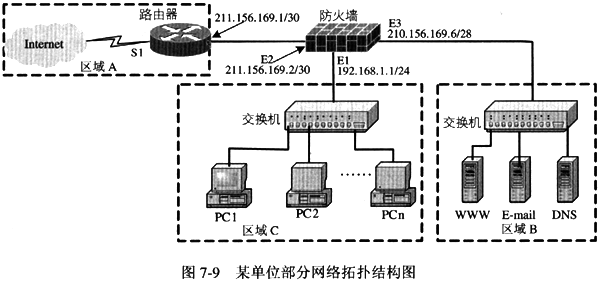【说明】
某单位在部署计算机网络时采用了一款硬件防火墙,该防火墙带有3个网络接口,其网络拓扑如图7-9所示。

【问题1】
防火墙包过滤规则的默认策略为拒绝,图7-10给出防火墙的包过滤规则配置界面。若要求内部所有主机能使用IE浏览器访问外部IP地址202.117.118.23的Web服务器,为图7-10中(1)~(4)空缺处选择正确答案。

(1)
- A.允许
- B.拒绝
(2)A.192.168.1.0/24B.211.156.169.6/30 - C.202.117.118.23/24
(3)A.TCPB.UDPC.ICMP
(4)A.E3→E2B.E1→E3C.E1→E2
参考答案:(1) A,或允许 (2) A,或192.168.1.0/2.4
(3) A,或TCP (4) C,或E1→E2
解析:这是一道要求读者掌握防火墙包过滤规则策略配置的分析理解题。本题的解答步骤如下。
①由试题中给出的关键信息“要求内部所有主机能……访问外部IP地址202.117.118.23的Web服务器”中,“能……访问”说明序号为1的包过滤规则策略为“允许”,即(1)空缺处的正确答案是选项A。
②试题中给出的关键信息“要求内部所有主机能……访问外部Ⅲ地址202.117.118.23的Web服务器”中的“内部所有主机”是指图7-9拓扑图中对应于区域C的计算机。由于防火墙与区域C相连接的接口 IP地址为192.168.1.1/24,其中“/24”表示子网掩码为255.255.255.0。因此区域C的网络组成的网段地址为192.168.1.0/24,即(2)空缺处应填入区域C的网段地址(192.168.1.0/24)。
③通常Web服务器是使用TCP/IP协议簇中的HTTP协议提供服务的,而HTTP协议是一个传输层基于TCP协议的应用层协议,因此(3)空缺处的“协议”应选择“TCP”。
④同理,由试题的关键信息“要求内部所有主机能……访问外部IP地址202.117.118.23的Web服务器”可知,该包过滤规则的控制方向是控制内部局域网传输给Internet网的IP包,即从防火墙的“E1”端口流入、“E2”端口流出的D数据包,因此(4)空缺处的“方向”应选择“E1→E2”。
